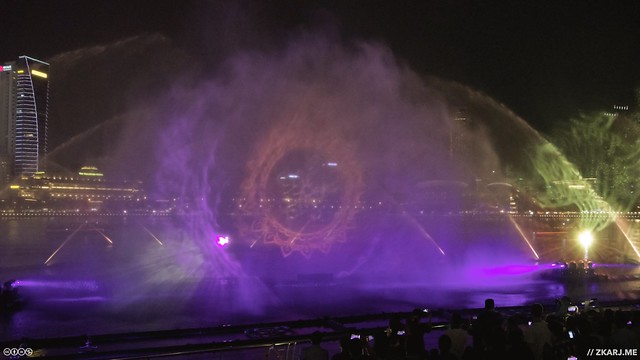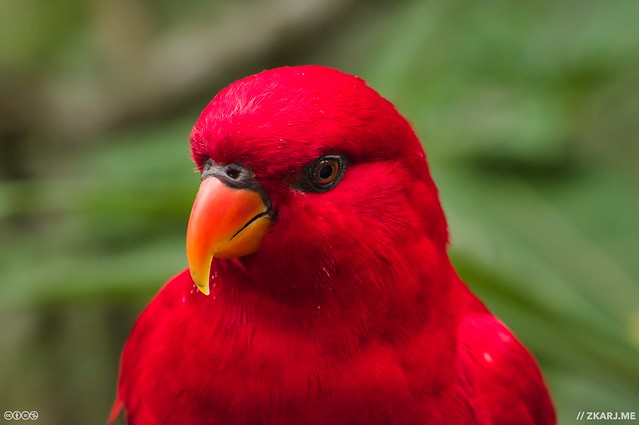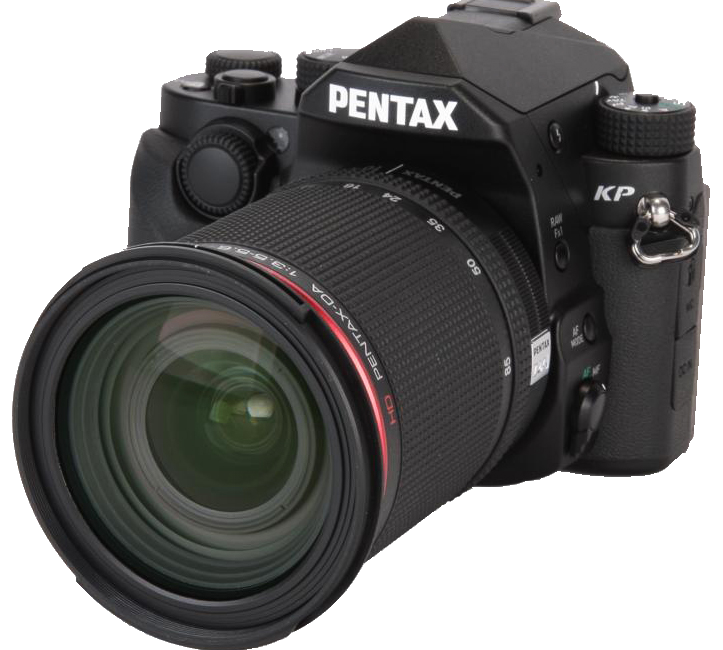In April I spent a week exploring Singapore, followed by three days in Melbourne, Australia and I took my “big boy” DSLR camera along to capture some of the sights. I also took a few other things with a view to solving a problem… how to take some of the 30 megabyte RAW files from my camera and publish them to Flickr with the same quality and standard as if I was at home. This is my story of how that turned out.
 To summarise I was able to publish a handful of photos successfully, but the process was far from straightforward. I’m glad I mostly figured it out before I left home, as there were still some problems I had to deal with in a hotel room.
To summarise I was able to publish a handful of photos successfully, but the process was far from straightforward. I’m glad I mostly figured it out before I left home, as there were still some problems I had to deal with in a hotel room.
I could have taken my 2016 13” MacBook Pro, but I didn’t want the weight and bulk of it while traveling, as it would have to be in my carry on bag and that was already tipping the scales at 6kg in its “flight configuration.” I would also have to concern myself with securing it while away. It seemed like overkill to process some photos. I should be able to do it with an iPad. My new iPad mini would be the perfect travel device at a slim 300g compared to the MacBook’s 1.3kg.
The first hurdle was how to get the photos to the iPad — I did not want the photos to end up in iCloud Photos! Apple’s Camera Connection Kit insists on doing this, but I had other ideas. I have previously reviewed the Western Digital MyPassport Pro Wireless hard drive for the podcast. This device made it pretty easy as I could dump my camera’s memory card directly onto the hard drive and use its built in wireless network and the WD MyCloud app to review the photos in full screen from my iPad. I also found it very easy to directly share a photo from MyCloud to a photo processing app. But which one?
When working out this process before my trip, I had settled on Affinity Photo, even though it is far, far more capable than I needed. However, just before I left home, Pixelmator Photo was released and this looked to be a much better match for my needs. Someone described it to me as “Luminar for iOS,” which immediately had me interested as Luminar is my current desktop software choice. I’ve reviewed Pixelmator Photo separately on podfeet.com. Importantly, it allows opening and saving of photos from the iOS File Picker, meaning the photos do not have to be in your Photos library.
Unfortunately, Pixelmator Photo lacked two features I wanted — noise reduction and vignette. I still had Affinity Photo to fall back on when these were needed and getting the photos published to Flickr was, I thought, going to be easy using the iOS Flickr app’s Share Sheet icon. More on that a little later, but these were essentially all of the pieces I would need.
 Each time I got back to my hotel room, I fished the MyPassport drive out of the room safe and turned it on. Once powered up, I inserted the SD card taken from the camera and waited for the lights to indicate the copy had completed. I feel it important to note here that, in addition to providing easy access to my photos, this was most crucially a backup copy of my photos that I was not carrying around with my camera. Next, I had the iPad join the MyPassport drive’s wifi and opened the WD MyCloud app, in which I could navigate to my latest photos. By viewing the photos full screen on the iPad, I chose one I wanted to work with and shared it directly to Pixelmator Photo. In Pixelmator Photo I tweaked exposure, vibrance, white balance and a few other things as needed. When done with those, I exported the result as a 16-bit TIFF to a folder within the “On this iPad” storage area. Next I opened Affinity Photo and loaded the image from that folder. This would have been easier had Affinity Photo had an available share sheet option from Pixelmator Photo, but it does not. Affinity Photo let me tame the noise (needed on some night shots) and add a vignette if required. Again, the result was saved, this time to an iCloud folder, as a full sized 16-bit TIFF file.
Each time I got back to my hotel room, I fished the MyPassport drive out of the room safe and turned it on. Once powered up, I inserted the SD card taken from the camera and waited for the lights to indicate the copy had completed. I feel it important to note here that, in addition to providing easy access to my photos, this was most crucially a backup copy of my photos that I was not carrying around with my camera. Next, I had the iPad join the MyPassport drive’s wifi and opened the WD MyCloud app, in which I could navigate to my latest photos. By viewing the photos full screen on the iPad, I chose one I wanted to work with and shared it directly to Pixelmator Photo. In Pixelmator Photo I tweaked exposure, vibrance, white balance and a few other things as needed. When done with those, I exported the result as a 16-bit TIFF to a folder within the “On this iPad” storage area. Next I opened Affinity Photo and loaded the image from that folder. This would have been easier had Affinity Photo had an available share sheet option from Pixelmator Photo, but it does not. Affinity Photo let me tame the noise (needed on some night shots) and add a vignette if required. Again, the result was saved, this time to an iCloud folder, as a full sized 16-bit TIFF file.
This is where I got a little clever. The folder I output the “final” version of the image to was a very specific folder in my iCloud Drive. At home, my Mac mini was running Hazel, which was watching that folder. When an image appeared in the folder, it would run a Retrobatch script to add my standard watermarks and convert to a JPEG of standard quality and dimensions, placing it back in a subfolder in iCloud. In my hotel room, once I had saved out the TIFF file to iCloud, I then opened the Files app and watched it upload, then disappear, then the new file appear in the subfolder. It was rather cool to watch, knowing there was a Mac 8,526km away doing my bidding in real time! For more information on how Retrobatch works, see my separate review, also on podfeet.com.
With the JPEG now Flickr-ready, there was one final hurdle to overcome. Despite being able to select the Flickr app to share the JPEG file with from the Files app, it steadfastly would not upload the photo, even though it went through the naming and tagging process. I discovered that I had to upload the images from the Photos library, so there was an extra step of saving the JPEG file there first and then uploading to Flickr.
 So with the MyPassport drive, my iPad, iCloud storage, Pixelmator Photo, Affinity Photo, and the Flickr app… not to mention my slave Mac mini at home… I was able to get an image from my DSLR uploaded to Flickr while in my hotel room without sacrificing quality or changing my standards. It’s not a simple process, though it would be much more streamlined if Pixelmator Photo had the two missing features (vignette and noise reduction) and if Flickr could cope with being given a file instead of a photo.
So with the MyPassport drive, my iPad, iCloud storage, Pixelmator Photo, Affinity Photo, and the Flickr app… not to mention my slave Mac mini at home… I was able to get an image from my DSLR uploaded to Flickr while in my hotel room without sacrificing quality or changing my standards. It’s not a simple process, though it would be much more streamlined if Pixelmator Photo had the two missing features (vignette and noise reduction) and if Flickr could cope with being given a file instead of a photo.
There will be some of you yelling at your browsers or podcast players about now saying I am making things hard for myself. Why not just use the Camera Connection Kit and iOS Photos and it would be a lot simpler? That’s true, but that way I’d have to choose which photos to import based purely on small thumbnails or, worse, import them all and delete those I don’t want. I keep all of my photos on my Mac hard drive, but only the best are polished and published and only those end up in my iCloud Photos library. Even with only the wanted images in the Photos library, the tools offered by the Photos app are rudimentary compared to what Pixelmator Photo offers even in its first version, and primitive compared to Affinity Photo.
What I have described is almost certainly not going to be useful to anyone else in exactly the same form, but hopefully it will give some of you inspiration to put together your own processes to suit your own needs. You can check out my separate reviews of the WD MyPassport, Pixelmator Photo, and Retrobatch on podfeet.com.
Finally, I have a caveat. I wrote this story before WWDC 2019. However, as I now come to record and publish it, it is clear the newly announced but yet to ship iPadOS 13 changes things a little. When iPadOS 13 is launched later this year, it will be possible using either version of Apple’s Camera Connection Kit to directly open a photo from the SD card or camera itself into an app such as Pixelmator Photo.


Hey Allister,
Thanks for the review. Been on the lookout for a replacement for Aperture for a while now. Tried many different things including some open source variants like DarkTable and RAWTherapee, and since I’ve had a Lightroom / Photoshop account for my son I tried that one too. But I just couldn’t find a tool which allowed me to organize and modify my pictres the way I did in Aperture. A month ago I took some pictures at a Family event and decided to give Lightroom another go … but again … I just couldn’t get into the workflow.
So … now that I’ve learned about Luminar, I’ll give that a spin and try to reprocess all those pictures in there. I’m really hoping it will fill the void for me, since Aperture is starting to get rather unstable (yes … I’ve kept using it all this time).
Hi Stefaan. I’m impressed you stuck with Aperture for so long, though I recall being very fond of it when I was using it. I just decided to “rip the bandaid off” when its demise was first announced.
Regarding Luminar, the (very) recent 3.1.2 update has brought performance up to roughly level with Lightroom, in my opinion. Prior to that the performance was a serious issue. Luminar still has some unsightly gaps in its capability — no inter-library movement and no meta-data editing are the key ones for me — but these things have been promised. The other thing to bear in mind is their promises, while they do deliver, tend to be optimistic on timeframe. I do believe those main gaps will be plugged this year.
However, it is Luminar’s processing engine that I have fallen in love with. Again, performance has not been stellar, but the latest update did improve things markedly, to the point where it’s very usable. I’m sure Allison won’t mind me including a link to my review of Luminar that I did for Essential Apple (who got me into the beta program for it). Note this was a review of the initial Luminar 3 release. https://essentialapple.com/reviewed/luminar-3-with-libraries/
Note that you can either use Luminar 3, which includes the library functionality, or Luminar Flex, which is the same processing engine packaged as a plugin for use in other library managers.
Hi Allister,
I already bought Luminar 3 … just need to start using it What I loved about aperture was indeed being able to keyword (hierachically) multiple photos and add location info to them. That and the ease of use of editing. Use cursor keys to quickly run through my images and press a few buttons in the inspector panels to tweak a few things. Lightroom never did it for me here … like in order to do some adjustments I always had to open panels, click on things select stuff … Adding a Vignette in Aperture was a matter of CTRL + V, control + S for sharpening, … and then cursor key for next picture …
What I loved about aperture was indeed being able to keyword (hierachically) multiple photos and add location info to them. That and the ease of use of editing. Use cursor keys to quickly run through my images and press a few buttons in the inspector panels to tweak a few things. Lightroom never did it for me here … like in order to do some adjustments I always had to open panels, click on things select stuff … Adding a Vignette in Aperture was a matter of CTRL + V, control + S for sharpening, … and then cursor key for next picture …
In Lightroom I always had to click on something to open an additional panel where I could choose to add a vignette of a certain type. Going to the next picutre always closes that panel which meant I have to do the whole clicking again. I just couldn’t stand the additional clicks I had to make (I’m a keyboard guy mostly). Maybe there is a keyboard shortcut for it, but I didn’t find it.
So … even if Luminar doesn’t provide me with everything I had in Aperture, I still bought it and will give it a spin. I’ll just have to get my thousands and thousands of pictures form all those Aperture years out of Aperture into a folder structure I can live with before I get them in Luminar.
Good to see that I’ve settled on the same photo editor on the Mac as none other than Allister Jenks, so I guess I’m on the right track.
Allison, have you ever given Luminar a go? I did a search of the Podfeet website and couldn’t find that you’ve tried it. Skylum seems to be serious about taking on Lightroom. And you have a choice of using the Luminar app or Luminar Flex, which is the plugin that can be used with Apple Photos and others.
In response to Stefaan please note that version 4 of Luminar is coming this fall. I think many of the items mentioned will appear in v4. The Sky Replacement demo on YouTube is awesome!
BTW, I still use Apple Photos as my Digital Asset Manager. My workflow is that I’ll put my photos from my phone or camera memory card into a folder on the Mac then import that folder into Luminar. After editing the photos I’ll export them into a different folder, then I REMOVE the folder from Luminar and import the edited photos into Apple Photos. In Photos I can do things that Luminar can’t do yet, such as manually sort the photos and using keywords and store videos with the photos. And I like the user interface in Apple Photos. And macOS 10.15 Catalina will add new features to Photos as well.